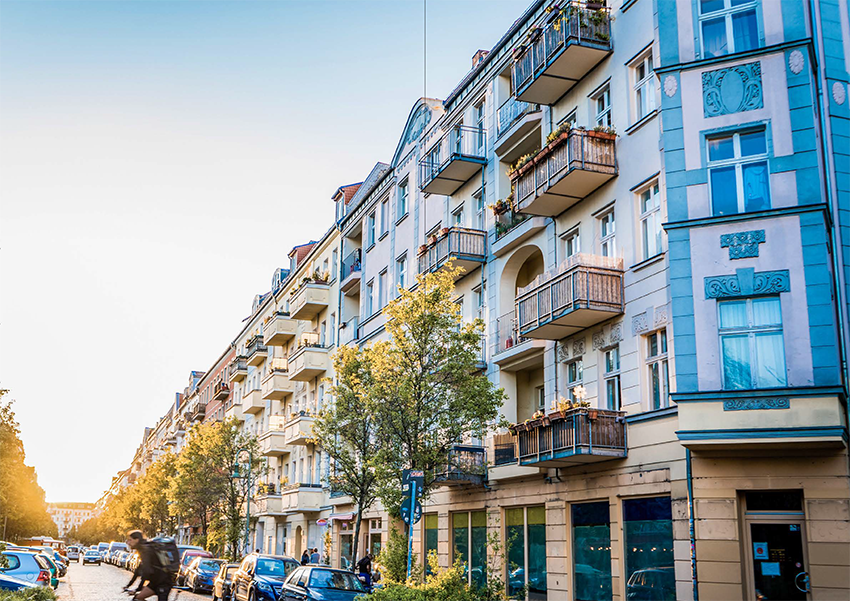Purchase prices for multifamily properties have dropped an average of 17% in Germany
- Report analyzes multifamily segment in 52 German cities
- Purchase prices and yields stabilize
- Rents will continue to rise significantly long term
- Germany’s rent prices remain reasonably affordable
Real estate advisor Colliers has been seeing a fundamental shift in the German residential and commercial investment markets ever since the ECB began raising interest rates in the summer of 2022. Purchase prices for multifamily properties have dropped an average of 17%, moving back to the levels recorded in 2018. We generally do not expect to see prices continue to fall, although slight corrections are still possible in some sub-segments. All of this and more is covered in the Colliers report “Residential investment 2023/24: An overview of residential/commercial-mix properties”.
“Germany’s housing shortage is intensifying because there is not enough construction activity. Rent prices at stock properties will inevitably continue to rise, which indicates that purchase prices will not continue to fall. In fact, purchase prices in many locations have bottomed out. It now makes sense for investors to get back in the market if they are convinced of a property’s quality,” says Felix von Saucken, Head of Residential Germany at Colliers.
Purchase prices and yields stabilize
According to the Colliers report, the fact that we will see net initial yields stabilize at a higher level also serves as an indicator that the price levels for residential and residential-commercial-mix properties have found a new equilibrium. Looking at Germany as a whole, multifamily yields rose from 3.9% in 2022 to a current 4.5%. In Germany’s top 7 cities of Berlin, Düsseldorf, Frankfurt, Hamburg, Cologne, Stuttgart, and Munich, yields were up from 3.0% in 2022 to a current 3.8%.
Rents will continue to rise significantly
Average rents in Germany’s top 50 cities rose 2% for stock properties and 4% for new-builds in H1 2023 alone. Rent increases were even more pronounced in the country’s top 7 cities, with 4% for stock properties and 6% for new-builds. We can expect this trend to be ongoing as construction activity remains insufficient while the number of households continues to rise. The German government has fallen short of its target of building roughly 400,000 new residential units each year, with only 295,000 built in 2022 and 245,000 expected to be built in 2023. And due to an almost 30% drop in the number of building permits issued in H1 2023, the actual figure for 2023 may be significantly lower. The completions forecast looks even more drab for 2024 (210,000 units) and 2025 (175,000).
However, despite the demographic shift, the Colliers report also found that more than 500,000 new households will be established in Germany’s 50 largest cities by 2035. This conclusion is based on the ongoing long-term trend that points to an increase in the average number of single-person households and the amount of space rented per person.
“The public debate around the housing shortage due to a lack of new construction has a basis. However, people often tend to ignore the demographic megatrend involving a steadily growing number of households. It is this combination of housing shortage and growing number of households that is behind the ongoing challenge on the German housing market,” says Felix von Saucken. “It may sound cynical, but buyers of multifamily properties will particularly benefit from this development, as a turnaround on the housing market is not foreseeable.”
Germany’s rent prices remain reasonably affordable
According to the Colliers analysis, rent prices in Germany are generally reasonably affordable from a purely economic standpoint, even in the country’s top 7 cities. Residential rents under new lease have risen an average of about 55% over the past 10 years in Germany’s top 7 cities. Average household income has risen by around 32% over the same period. In terms of the correlation between residential rent and household income, the average rent burden came to roughly 30% in 2022. Ten years ago, this correlation came to around 25% in the country’s top 7 cities. This calculation is based on basic rent for a 95 sqm apartment under new lease.
“In Germany, it is not the most popular thing to say that rents are generally still affordable. A rent burden of 30%, however, can be considered reasonable. Still, we definitely need to make sure that the situation for low-income households does not continue to worsen. There is a risk that they could be left behind by the market and the real estate sector, and politicians need to work together here to find solutions. Generally speaking, however, investors in multifamily properties still have excellent prospects when it comes to finding suitable tenants,” concludes Felix von Saucken.
You can download the complete report in German including an analysis of the housing markets in
Germany’s 52 largest cities here:
https://www.colliers.de/residential-investment-2023-2024/









